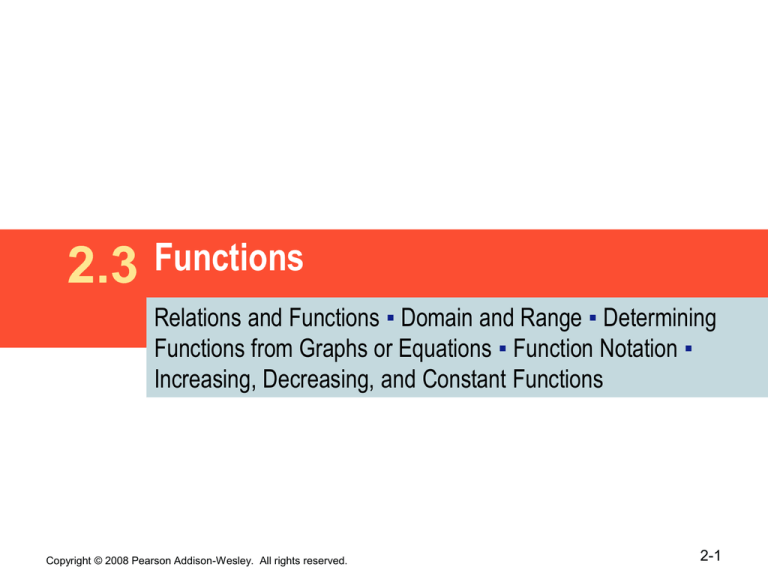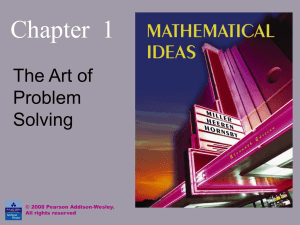
2.3
Functions
Relations and Functions ▪ Domain and Range ▪ Determining
Functions from Graphs or Equations ▪ Function Notation ▪
Increasing, Decreasing, and Constant Functions
Copyright © 2008 Pearson Addison-Wesley. All rights reserved.
2-1
2.3 Example 1 Deciding Whether Relations Define
Functions (page 202)
Decide whether the relation determines a function.
M is a function because each distinct x-value has
exactly one y-value.
Copyright © 2008 Pearson Addison-Wesley. All rights reserved.
2-2
2.3 Example 1 Deciding Whether Relations Define
Functions (cont.)
Decide whether the relation determines a function.
N is a function because each distinct x-value has
exactly one y-value.
Copyright © 2008 Pearson Addison-Wesley. All rights reserved.
2-3
2.3 Example 1 Deciding Whether Relations Define
Functions (cont.)
Decide whether the relation determines a function.
P is not a function because the x-value –4 has two
y-values.
Copyright © 2008 Pearson Addison-Wesley. All rights reserved.
2-4
2.3 Example 2(a) Deciding Whether Relations Define
Functions (page 203)
Give the domain and range of the relation. Is the
relation a function?
{(–4, –2), (–1, 0), (1, 2), (3, 5)}
Domain: {–4, –1, 0, 3}
Range: {–2, 0, 2, 5}
The relation is a function because each x-value
corresponds to exactly one y-value.
Copyright © 2008 Pearson Addison-Wesley. All rights reserved.
2-5
2.3 Example 2(b) Deciding Whether Relations Define
Functions (cont.)
Give the domain and range of the relation. Is the
relation a function?
Domain: {1, 2, 3}
Range: {4, 5, 6, 7}
The relation is not a function because the x-value
2 corresponds to two y-values, 5 and 6.
Copyright © 2008 Pearson Addison-Wesley. All rights reserved.
2-6
2.3 Example 2(c) Deciding Whether Relations Define
Functions (cont.)
Give the domain and
range of the relation. Is
the relation a function?
Domain: {–3, 0, 3, 5}
x
y
–3
5
0
5
3
5
5
5
Range: {5}
The relation is a function because each x-value
corresponds to exactly one y-value.
Copyright © 2008 Pearson Addison-Wesley. All rights reserved.
2-7
2.3 Example 3(a) Finding Domains and Ranges from
Graphs (page 204)
Give the domain and range of the relation.
Domain: {–2, 4}
Range: {0, 3}
Copyright © 2008 Pearson Addison-Wesley. All rights reserved.
2-8
2.3 Example 3(b) Finding Domains and Ranges from
Graphs (cont.)
Give the domain and range of the relation.
Domain:
Range:
Copyright © 2008 Pearson Addison-Wesley. All rights reserved.
2-9
2.3 Example 3(c) Finding Domains and Ranges from
Graphs (cont.)
Give the domain and range of the relation.
Domain: [–5, 5]
Range: [–3, 3]
Copyright © 2008 Pearson Addison-Wesley. All rights reserved.
2-10
2.3 Example 3(d) Finding Domains and Ranges from
Graphs (cont.)
Give the domain and range of the relation.
Domain:
Range:
Copyright © 2008 Pearson Addison-Wesley. All rights reserved.
2-11
2.3
Example 4(a) Using the Vertical Line Test (page 206)
Use the vertical line test to determine if the relation
is a function.
Not a function
Copyright © 2008 Pearson Addison-Wesley. All rights reserved.
2-12
2.3
Example 4(b) Using the Vertical Line Test (cont.)
Use the vertical line test to determine if the relation
is a function.
Function
Copyright © 2008 Pearson Addison-Wesley. All rights reserved.
2-13
2.3
Example 4(c) Using the Vertical Line Test (cont.)
Use the vertical line test to determine if the relation
is a function.
Not a function
Copyright © 2008 Pearson Addison-Wesley. All rights reserved.
2-14
2.3
Example 4(d) Using the Vertical Line Test (cont.)
Use the vertical line test to determine if the relation
is a function.
Function
Copyright © 2008 Pearson Addison-Wesley. All rights reserved.
2-15
2.3
Example 5(a) Identifying Functions, Domains, and
Ranges (page 206)
Determine if the relation is a function and give the
domain and range.
y = 2x – 5
y is found by multiplying x
by 2 and subtracting 5.
Each value of x
corresponds to just one
value of y, so the relation
is a function.
Domain:
Range:
Copyright © 2008 Pearson Addison-Wesley. All rights reserved.
2-16
2.3
Example 5(e) Identifying Functions, Domains, and
Ranges (cont.)
Determine if the relation is a function and give the
domain and range.
y = x2 + 3
y is found by squaring x by
2 and adding 3.
Each value of x corresponds
to just one value of y, so the
relation is a function.
Domain:
Range:
Copyright © 2008 Pearson Addison-Wesley. All rights reserved.
2-17
2.3
Example 5(c) Identifying Functions, Domains, and
Ranges (cont.)
Determine if the relation is a function and give the
domain and range.
x = |y|
For any choice of x in the
domain, there are two
possible values for y.
The relation is not a function.
Domain:
Range:
Copyright © 2008 Pearson Addison-Wesley. All rights reserved.
2-18
2.3
Example 5(d) Identifying Functions, Domains, and
Ranges (cont.)
Determine if the relation is a function and give the
domain and range.
y ≥ –x
If x = 1, for example, there
are many values of y that
satisfy the relation.
The relation is not a function.
Domain:
Range:
Copyright © 2008 Pearson Addison-Wesley. All rights reserved.
2-19
2.3
Example 5(e) Identifying Functions, Domains, and
Ranges (cont.)
Determine if the relation is a function and give the
domain and range.
y is found by dividing 3 by
x + 2.
Each value of x corresponds
to just one value of y, so the
relation is a function.
Domain:
Copyright © 2008 Pearson Addison-Wesley. All rights reserved.
Range:
2-20
2.3
Example 6 Using Function Notation (page 209)
Let
and
Find f(–3), f(r), and g(r + 2).
Copyright © 2008 Pearson Addison-Wesley. All rights reserved.
.
2-21
2.3
Example 7 Using Function Notation (page 209)
Find f(–1) for each function.
(a) f(x) = 2x2 – 9
f(–1) = 2(–1)2 – 9 = –7
(b) f = {(–4, 0), (–1, 6), (0, 8), (2, –2)}
f(–1) = 6
Copyright © 2008 Pearson Addison-Wesley. All rights reserved.
2-22
2.3
Example 7 Using Function Notation (cont.)
Find f(–1) for each function.
(c)
(d)
f(–1) = 5
Copyright © 2008 Pearson Addison-Wesley. All rights reserved.
f(–1) = 0
2-23
2.3
Example 8(a) Writing Equations Using Function Notation
(page 210)
Assume that y is a function of x. Write the equation
using function notation. Then find f(–5) and f(b).
y = x2 + 2x – 3
f(x) = x2 + 2x – 3
f(–5) = (–5)2 + 2(–5) – 3 = 12
f(b) = b2 + 2b – 3
Copyright © 2008 Pearson Addison-Wesley. All rights reserved.
2-24
2.3
Example 8(b) Writing Equations Using Function Notation
(page 210)
Assume that y is a function of x. Write the equation
using function notation. Then find f(–5) and f(b).
2x – 3y = 6
Solve for y:
Copyright © 2008 Pearson Addison-Wesley. All rights reserved.
2-25
2.3
Example 9 Determining Intervals Over Which a Function
is Increasing, Decreasing, or Constant
(page 212)
The figure is the graph of a
function. Determine the
intervals over which the
function is increasing,
decreasing, or constant.
Increasing on
Decreasing on
Constant on
Copyright © 2008 Pearson Addison-Wesley. All rights reserved.
2-26
2.3
Example 10 Interpreting a Graph (page 212)
Over what period of time is
the water level changing
most rapidly?
from 0 hours to 25 hours
After how many hours
does the water level
start to decrease?
after 50 hours
Copyright © 2008 Pearson Addison-Wesley. All rights reserved.
2-27
2.3
Example 10 Interpreting a Graph (cont.)
How many gallons of water
are in the pool after 75
hours?
2000 gallons
Copyright © 2008 Pearson Addison-Wesley. All rights reserved.
2-28







